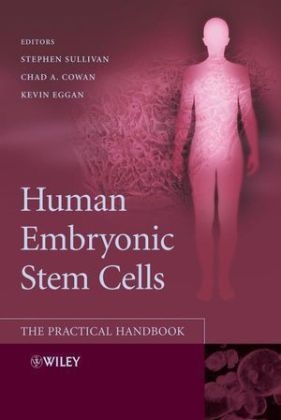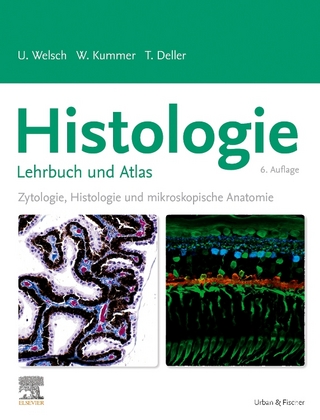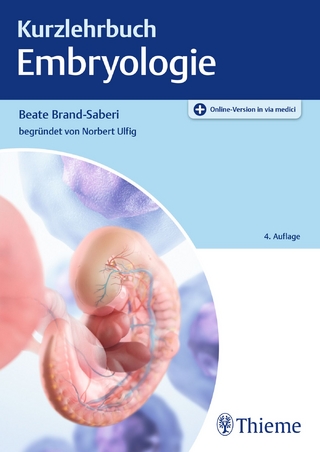
Human Embryonic Stem Cells
John Wiley & Sons Inc (Verlag)
978-0-470-03356-2 (ISBN)
- Titel z.Zt. nicht lieferbar
- Versandkostenfrei innerhalb Deutschlands
- Auch auf Rechnung
- Verfügbarkeit in der Filiale vor Ort prüfen
- Artikel merken
With this valuable practical guide, three members of the Harvard Stem Cell Institute have compiled and edited the definite handbook for the exciting new field of human embryonic stem cell research. The editors have gathered protocols from scientists with extensive reputation and expertise, describing and comparing currently used techniques for the culture of human stem cells and discussing the strengths and weaknesses of the different approaches. Human Embryonic Stem Cells: The Practical Handbook contains the first centralised collection of methods used in human embryonic stem cell biology. The book covers the derivation of human stem cell lines, the obtaining of cells from human stem cell banks, the culturing and characterisation of the cells, and the differentiation of the cells in vitro and in vivo. Lastly, almost all of these protocols can also be used for analyzing and manipulating induced pluripotency iPS stem cells. This allows an even greater number of opportunities for those interested in purusing work in pluripotent stem cells, disease modelling, and other aspects of basic regenerative medicine research.
The novel and useful focus of this book sets it apart from other available books:
Compares and evaluates the protocols used in leading laboratories working on human embryonic stem cells
Centred solely on practical protocols for human (not mouse) embryonic stem cell research
Includes extensive troubleshooting sections
Addresses the different proclivities and behaviours of individual human embryonic cell lines
Contains techniques currently known only to a small number of specialised laboratories worldwide
This handbook represents an essential source of up-to-date practical information for all cell and developmental biologists working with human embryonic stem cells or wishing to enter the field. It is also essential reading for clinical researchers in areas such as diabetes, cardiovascular disease, and neurological diseases.
Praise from the reviews:
"...a highly readable and useful book… A notable feature of the book is its air of openness and honesty… This book… will help many to navigate the uncharted waters of human embryonic stem cell biology." BRITISH SOCIETY FOR CELL BIOLOGY
"... the imaginative solutions in this book can inspire us to get past our most frustrating limitations." CELL STEM CELL
"... the richness in the details of each protocol presented will certainly encourage more scientists to begin studies of Human pluripotent stem cells..." REGENERATIVE MEDICINE
"In this fast-moving field, this [handbook] will help drive advances of more and more researchers." DIFFERENTIATION
"...a valuable resource for seasoned and novice researchers... an excellent addition to the reference collection of any medical library or research laboratory." THE AMERICAN MEDICAL ASSOCIATION
Stephen Sullivan: Trinity College, Dublin, Ireland Kevin Eggan: Harvard University, Cambridge, MA, USA Chad A. Cowan: Harvard University, Cambridge, MA, USA
Foreword. Davor Solter Preface.
Section 1: Obtaining and culturing human embryonic stem cells.
1 Organization and good aseptic technique in the human embryonic stem cell laboratory.
Minal J Patel, Emma L Stephenson, and Stephen L Minger
2 Sourcing human embryonic stem cell lines.
Glyn Stacey
3 Human embryo culture for human embryonic stem cell derivation.
R. Douglas Powers and Jeannine Witmyer
4 Derivation of human embryonic stem cell lines.
Stephen Sullivan, Dieter Egli, Hidenori Akutsu, Douglas A. Melton, Kevin Eggan and Chad A. Cowan
5 Standard culture of human embryonic stem cells.
Jeremy M. Crook, Rachel Horne, and Alan Colman
6 Culture of human embryonic stem cells in chemically defined conditions.
Julie Hsu Clark and Sheng Ding
Section 2: Characterization of undifferentiated embryonic stem cells.
7 Phenotypic analysis of human embryonic stem cells.
Jonathan S. Draper, Cheryle A. Séguin and Peter W. Andrews
8 Genetic and epigenetic analysis of human embryonic stem cells.
Laurie A. Boyer, Rudolf Jaenisch, and Maisam Mitalipova
Section 3: Manipulation of human embryonic stem cells.
9 In vivo differentiation of human embryonic stem cells.
Scott A. Noggle, Francesca M. Spagnoli, Ali H. Brivanlou
10 In vitro differentiation of human embryonic stem cells.
A. Henry Sathananthan and Alan Trounson
11 Differentiation of human embryonic stem cells into extraembryonic cell types.
Cheryle A. Séguin and Jonathan S. Draper
12 Directed differentiation of human embryonic stem cells into:
(a) Early endoderm cells.
Kenji Osafune, Alice E. Chen and Douglas A. Melton
(b) Hepatic cells.
Neta Lavon and Nissim Benvenisty
(c) Pancreatic cells.
Hiram Chipperfield
13 Directed differentiation of human embryonic stem cells into:
(a) Cardiomyocytes.
Christine Mummery, Robert Passier and Chris Denning
(b) Endothelial cells.
Carrie Soukup, Shulamit Levenberg and Ondine Cleaver
(c) Osteogenic cells.
Jeffrey M. Karp, Alborz Mahdavi, Lino S. Ferreira, Ali Khademhosseini and Robert Langer
(d) Hematopoietic in vivo repopulating cells.
Shannon McKinney-Freeman, Thorsten M. Schlaeger and George Q. Daley
(e) Lymphocytes.
Petter S. Woll and Dan S. Kaufman
(f) Myeloid cells.
Chantal Cerdan and Mickie Bhatia
14 Directed differentiation of human embryonic stem cells into:
(a) Forebrain neurons.
Emily A. Davis and Lawrence S.B. Goldstein
(b) Dopaminergic neuron.
Jan Pruszak and Ole Isacson
(c) Spinal motor neurons.
Bao-Yang Hu and Su-Chun Zhang
15 (a) Gene targeting: knock out and knock in by homologous recombination.
Thomas P. Zwaka
(b) RNA interference in human embryonic stem cells.
M. William Lensch, Asmin Tulpule and Holm Zaehres
(c) Generation of gene reporters using bacterial artificial chromosome recombineering. Andrew J. Washkowitz and David A. Shaywitz
Afterword. Azim Surani
Index.
| Erscheint lt. Verlag | 1.8.2007 |
|---|---|
| Verlagsort | New York |
| Sprache | englisch |
| Maße | 173 x 249 mm |
| Gewicht | 816 g |
| Einbandart | gebunden |
| Themenwelt | Medizin / Pharmazie ► Medizinische Fachgebiete ► Laboratoriumsmedizin |
| Medizin / Pharmazie ► Medizinische Fachgebiete ► Mikrobiologie / Infektologie / Reisemedizin | |
| Studium ► 1. Studienabschnitt (Vorklinik) ► Histologie / Embryologie | |
| Naturwissenschaften ► Biologie ► Genetik / Molekularbiologie | |
| Naturwissenschaften ► Biologie ► Humanbiologie | |
| Naturwissenschaften ► Biologie ► Mikrobiologie / Immunologie | |
| ISBN-10 | 0-470-03356-8 / 0470033568 |
| ISBN-13 | 978-0-470-03356-2 / 9780470033562 |
| Zustand | Neuware |
| Informationen gemäß Produktsicherheitsverordnung (GPSR) | |
| Haben Sie eine Frage zum Produkt? |
aus dem Bereich


